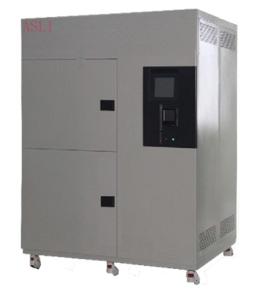The thermal shock test chamber is a critical testing device used across industries such as aviation, automotive, home appliances, and scientific research. It helps evaluate and determine the performance and parameters of electrical, electronic, automotive, and material products after exposure to extreme temperature changes during high and low-temperature tests. In this article, we’ll discuss important considerations when placing test samples in a thermal shock test chamber.
During a thermal shock test, if multiple samples are placed in the same chamber, it’s essential that all samples are exposed to the same ambient temperature and placed under identical conditions. This ensures uniformity in the test results and avoids discrepancies caused by varying environmental factors.
For heat-generating samples, the temperature differences between individual samples due to radiated heat are usually minimal and can be considered negligible. However, for non-heat-generating samples, if they are subjected to the same high or low-temperature test, the spacing between them may not be strictly necessary. Once the chamber reaches a stable temperature, the samples will also reach equilibrium with the chamber temperature, and no further heat exchange will occur. Therefore, in such cases, the spacing between samples has little impact on the test outcome.
However, for non-heat-dissipating test specimens undergoing temperature change tests, it’s recommended to maintain proper spacing between them. This allows sufficient airflow around the samples, which helps accelerate the heat exchange process between the samples and the chamber. Proper spacing ensures that the samples reach the required test temperature more quickly and accurately, improving the overall reliability of the test.
In addition to spacing, it’s also important to ensure that the samples are positioned correctly within the chamber, avoiding direct contact with the chamber walls or other objects that could interfere with temperature distribution. The placement should allow for even exposure to the thermal environment, ensuring that all samples experience the same conditions throughout the test cycle.
Understanding these placement guidelines is crucial for obtaining accurate and repeatable results from thermal shock tests. Whether you're conducting routine testing or developing new products, following these best practices will help optimize your testing procedures. For more insights and updates, be sure to continue visiting this website.

Wardrobe, also known as an armoire or closet, is a piece of furniture specifically designed for storing clothes, accessories, and other personal items. It typically consists of hanging space, shelves, drawers, and sometimes a mirror. Here are some key aspects to consider when choosing a wardrobe:
-
Size and Space: Measure the available space in your room to determine the size of the wardrobe that will fit comfortably. Consider the height, width, and depth of the wardrobe, as well as the space required for opening and closing its doors.
-
Storage Capacity: Assess your storage needs and choose a wardrobe with sufficient space to accommodate your clothing collection. Consider the number of hanging rails, shelves, and drawers required to store your clothes, accessories, and other items. Adjustable shelves and removable drawers can provide flexibility for organizing your belongings.
-
Design and Style: Select a wardrobe that matches the overall style and aesthetic of your room. Whether you prefer a modern, contemporary, traditional, or rustic design, choose a wardrobe that complements the existing decor. Pay attention to details such as the shape, finish, handles, and hardware to ensure they align with your desired style.
-
Material: Wardrobes are available in a variety of materials, including wood, metal, or a combination of both. Choose a material that suits your style preferences, durability requirements, and maintenance preferences. Solid wood offers a classic and timeless look, while metal wardrobes can provide a more industrial or modern feel.
-
Internal Organization: Consider the internal organization options of the wardrobe. Look for features such as adjustable shelves, removable dividers, built-in drawers, and compartments designed to store specific items like shoes, ties, or jewelry. A well-organized interior can maximize the storage capacity and make it easier to find and access your belongings.
-
Mirror: Some wardrobes come with built-in mirrors on the doors or as part of the wardrobe structure. A mirror can be a convenient addition, allowing you to check your appearance while getting dressed and potentially eliminating the need for a separate full-length mirror in your room.
-
Door Type: Wardrobes can have different door configurations, such as hinged doors, sliding doors, or a combination of both. Consider the space available in your room and the accessibility you prefer when choosing the door type. Sliding doors can save space and provide a sleek look, while hinged doors offer a more traditional and open feel.
Bedroom Wardrobe,Wooden Wardrobe,Wardrobe with Mirror,Morden Wardrobe,Silding Wardrobe
Ningbo Greenly Industy Co.,LTD. , https://www.chinagreenly.com